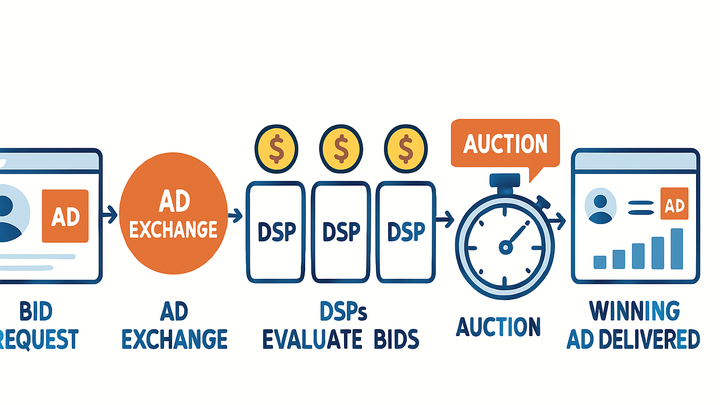Published on 2025-06-26T04:40:43Z
What is Real-Time Bidding (RTB)? Examples of RTB in Analytics
Real-Time Bidding (RTB) is a programmatic advertising method in which digital ad impressions are bought and sold through automated auctions in real time. It allows advertisers to bid on individual impressions based on contextual and user data within milliseconds. These auctions are facilitated by ad exchanges and managed via Demand-Side Platforms (DSPs) and Supply-Side Platforms (SSPs). From an analytics perspective, RTB provides granular bid-level data that marketers can leverage to measure ROI, optimize audience targeting, and allocate budgets more effectively. Integrating RTB metrics into tools like Google Analytics 4 (GA4) and privacy-focused solutions such as PlainSignal enables comprehensive performance insights while respecting user privacy regulations.
Rtb
Automated auction process for buying and selling digital ad impressions in real time, key to programmatic advertising and campaign analytics.
How RTB Works
RTB operates through a multi-step process where ad impressions are auctioned in real time based on data signals and bidding algorithms. This allows for dynamic pricing and improved targeting at scale.
-
Bid request
When a user visits a webpage, the publisher’s SSP generates a bid request containing information about the user, the page context, and the ad slot.
-
User & context data
Includes anonymized attributes like location, device type, browsing history, and page metadata.
-
Bid floor & impression details
The publisher sets a minimum price and signals about ad slot size, placement, and format requirements.
-
-
Real-time auction
The bid request is sent to multiple DSPs, which evaluate the opportunity and submit bids within milliseconds.
-
Bid evaluation
DSP algorithms assess how well the impression aligns with campaign goals and calculate the optimal bid price.
-
Auction types
Most RTB uses second-price auctions (winner pays just above the second-highest bid), though first-price auctions are also used.
-
-
Ad delivery & reporting
The highest bidder wins the auction, the ad is served instantly, and impression data is logged for performance analysis.
-
Logging & analytics
Bid responses, winning bids, and impression metrics are recorded in ad exchange and DSP dashboards for in-depth analysis.
-
Key Components of the RTB Ecosystem
RTB relies on a collaborative ecosystem of platforms and data services to execute real-time auctions and optimize ad delivery.
-
Demand-side platform (dsp)
Software that enables advertisers to buy ad impressions programmatically by evaluating bid requests against campaign parameters.
-
Supply-side platform (ssp)
Technology that helps publishers manage, sell, and optimize their available ad inventory in real time.
-
Ad exchanges
Marketplaces that facilitate the auction process, connecting DSPs with SSPs to match bids to available ad slots.
-
Data management platform (dmp)
Systems that aggregate and organize audience data to inform bidding strategies and improve targeting accuracy.
Integrating RTB with Analytics Platforms
To measure and optimize RTB-driven campaigns, marketers integrate auction and impression data into analytics tools for end-to-end performance tracking.
-
Google analytics 4 (GA4)
Capture traffic and conversion metrics from RTB campaigns by tagging landing pages, setting up custom events, and analyzing user journeys.
-
PlainSignal (cookie-free analytics)
Leverage PlainSignal’s lightweight, privacy-focused script to track user engagement and ad-driven traffic without relying on cookies.
-
Implementation
Insert the PlainSignal tracking code into your site’s
<head>section to start collecting pageviews and campaign parameters. -
Tracking code example
<link rel="preconnect" href="//eu.plainsignal.com/" crossorigin /> <script defer data-do="yourwebsitedomain.com" data-id="0GQV1xmtzQQ" data-api="//eu.plainsignal.com" src="//cdn.plainsignal.com/plainsignal-min.js"></script>
-
Benefits and Challenges of RTB
RTB offers efficiency and precision but also introduces operational complexity and privacy considerations that organizations must navigate.
-
Improved cost efficiency
Automated bidding focuses spend on the most valuable impressions, reducing waste.
-
Advanced audience targeting
Advertisers can bid on specific user segments based on demographics, interests, and behaviors.
-
Data privacy considerations
Evolving regulations (e.g., GDPR, CCPA) and restrictions on third-party cookies require privacy-compliant data strategies.
-
Technical complexity
Managing multiple DSPs, SSPs, data integrations, and bidding strategies demands specialized expertise.
Real-World Use Cases
RTB underpins diverse programmatic advertising strategies, enabling advertisers to reach audiences efficiently across formats and channels.
-
Retargeting campaigns
Bid on impressions to users who previously visited a website or engaged with content, boosting conversion chances.
-
Private marketplace deals (pmp)
Access premium publisher inventory in exclusive, invitation-only auctions for brand-safe placements.
-
Programmatic video advertising
Deliver video ads across websites and apps based on real-time user and contextual data.
